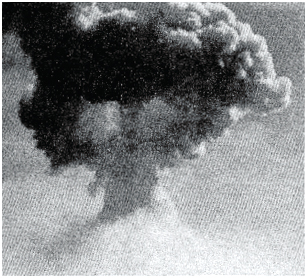 Explosion nucléaire simulée au-dessus du polygone de Wittstock en 1967.
La bombe de type IAB-500 fut largée par un Su-7 au cours d'une ressource (LABS). © USMLM.
Explosion nucléaire simulée au-dessus du polygone de Wittstock en 1967.
La bombe de type IAB-500 fut largée par un Su-7 au cours d'une ressource (LABS). © USMLM.
Simulated nuclear explosion above the Wittstock range in 1967.
The IAB-500 bomb was released from a Su-7 during a LABS manoeuvre. © USMLM.
It is a well-known fact that the Soviet Air Forces in Eastern Europe received a large number of nuclear weapons in the early
1960s. During this period, the Yak-28 'Brewer' tactical bomber and the first genuine Soviet jet fighter-bomber, the
Su-7 "Fitter," were introduced to service and provided the most potent offensive capabilities. The nuclear weapons
systems were stationed on what would have been the front line in the event of a confrontation with the West: in East
Germany, Poland and Hungary. The Air Force divisions of a purely offensive nature were the recipients of these weapons,
and their structures in the German Democratic Republic and Poland were representative. The spearhead was the 132.BAD east
of Berlin, supported by the 125.IBAD (later ADIB) in the north and the 105.IBAD in the south of East Germany. The
149.IBAD of the 4.VA was based in the south-west of Poland. The offensive capability of Soviet air units was not as high
in Hungary. The 36.VA was located there with two nuclear-capable Air Regiments, one at Kunmadaras and another at
Debrecen. These units were mostly equipped with MiG-17 'Frescos' and Il-28 'Beagles' in the 1950s, followed by Su-7 and
Yak-28 in the 1960s. Development led to a force that consisted of approximately one-third conventional and two-thirds
nuclear armament. During the 1970s, the deployment of the Su-17M/M2 "Fitter-C/D" and MiG-27 "Flogger-D" meant that all
offensive air units in Eastern Europe had a nuclear capability, while a new offensive potential was provided in the 80s
with the introduction of the Su-24 "Fencer-B/C."
How the West found out
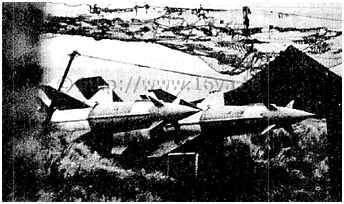 Une batterie de missiles sol-air 5V24 - système S-125 (SA-3 "Goa") - photographiée par une équipe "Air" de la USMLM à Köthen en 1973. © USMLM.
Une batterie de missiles sol-air 5V24 - système S-125 (SA-3 "Goa") - photographiée par une équipe "Air" de la USMLM à Köthen en 1973. © USMLM.
A S-125 SAM system battery photographed by a USMLM air team at Köthen in 1973. © USMLM.
An interesting incident shows the high priority of one of the first-generation bases for these "special" weapons as they
were called by the Soviets.
It is known that, beginning in the summer of 1967, as a result of the Arab-Israeli Six-Day War, two dozen air defence
missile sites were activated in the GDR within only a few months. Construction work for such a site was discovered at the
Brand bomber base in August 1967 by Western military liaison missions. The site turned out to be the first location for
the new S-125 Neva (SA-3 'Goa') surface-to-air missile system in GDR, demonstrating the high level of importance of
that particular base. The 668.BAP, equipped with Yak-28, was stationed there, and because of the unit's nearby storage of
nuclear weaponry it was then the spearhead of the Soviet Air Forces in Eastern Europe. It took a handful of dramatic
Cold War events for the West to discover that nuclear weaponry had been deployed in Eastern Europe.
| 24.VA nuclear potential in 1967 |
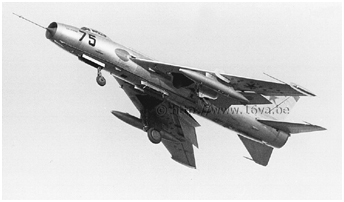 As a matter of fact, NATO was very poorly informed about Soviet nuclear air power potential during the mid-1960s.
Construction at five bases in the GDR, Poland and Hungary was noticed almost right away and thoroughly
documented, yet it is not known exactly what was stored there. Once-secret documents from the CIA and USMLM (the
United States Military Liaison Mission in East Germany - see > links) which have since been
de-classified could be of some help here. A US intelligence paper ("Capabilities of Soviet General Purpose Forces")
from December 1964 about Soviet military capabilities contained a surprising summary: "We have only discovered nuclear
weapons in the USSR so far.
If the Soviets did not store such weapons in Eastern Europe (its western part), then
it would be a great logistical and time consuming effort for them."
As a matter of fact, NATO was very poorly informed about Soviet nuclear air power potential during the mid-1960s.
Construction at five bases in the GDR, Poland and Hungary was noticed almost right away and thoroughly
documented, yet it is not known exactly what was stored there. Once-secret documents from the CIA and USMLM (the
United States Military Liaison Mission in East Germany - see > links) which have since been
de-classified could be of some help here. A US intelligence paper ("Capabilities of Soviet General Purpose Forces")
from December 1964 about Soviet military capabilities contained a surprising summary: "We have only discovered nuclear
weapons in the USSR so far.
If the Soviets did not store such weapons in Eastern Europe (its western part), then
it would be a great logistical and time consuming effort for them."
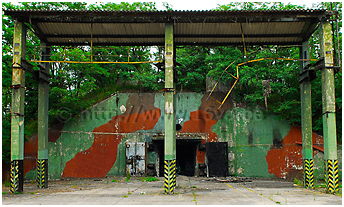 L'entrée des abris de première génération de Type 641 pour armes nucléaires était surmontée d'un portique équipé
de treuils afin de charger les armes sur des véhicules (Finsterwalde). © S.Meeter.
L'entrée des abris de première génération de Type 641 pour armes nucléaires était surmontée d'un portique équipé
de treuils afin de charger les armes sur des véhicules (Finsterwalde). © S.Meeter.
The entrance of the first generation Type 641 storage shelters for nuclear weapons were dominated by
a gantry equipped with winches to load the weapons on vehicles (Finsterwalde). © S.Meeter.
"They would need a large number of An-12 transports
for a task like this. Because of all this we believe that they already store such weapons close to the "front"
(eg East Germany). However, this still remains unconfirmed to us." The first proof of training activities with nuclear
weapons can be found in the annual report of the USMLM in 1967. The unit involved was the 20.GvIBAP. "On 4 August,
Parchim-based "Fitter" aircraft performed LABS [manoeuvres or toss bombing] over the Gadow-Rossow bomb range with bombs with air
burst leaving a heretofore unseen mushroom-shaped cloud. This was the first observation of such bombing technique
using air bursts with the appearances of a nuclear explosion-shaped cloud."
It is most likely that this was a
training scenario with a practice or dummy bomb of the IAB-500 type, which was a training device for tactical
nuclear bombs.
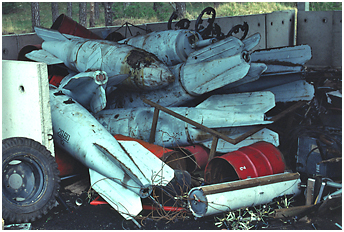 The designation IAB-500 (Imitatsionnaya Aviatsionaya Bomba - simulation aviation bomb)
also informs us of the weapon's size and specifications. That bomb used the same aerodynamical body as the 8U46/8U47/8U49 tactical
nuclear bombs. The IAB-500 served not only to instruct the loading, transport and guard personnel for
such weapons, but was actually a conventional weapon itself. The contents consisted of a highly explosive mixture
of 150kg of kerosene, 58kg of white phosphorus and 34kg of explosives (TNT and TGA 11).
The explosives that detonated above the target (1)
broke the body of the bomb and freed the phosphorus which, in turn, inflamed the kerosene.
The explosion provoked a fireball followed by a rapidly growing and billowing mushroom cloud (the phosphorus coloured the cloud white for added realism) -
all the tell-tale signs of a nuclear explosion. Witnesses reported clouds of up to 200 meters!
The designation IAB-500 (Imitatsionnaya Aviatsionaya Bomba - simulation aviation bomb)
also informs us of the weapon's size and specifications. That bomb used the same aerodynamical body as the 8U46/8U47/8U49 tactical
nuclear bombs. The IAB-500 served not only to instruct the loading, transport and guard personnel for
such weapons, but was actually a conventional weapon itself. The contents consisted of a highly explosive mixture
of 150kg of kerosene, 58kg of white phosphorus and 34kg of explosives (TNT and TGA 11).
The explosives that detonated above the target (1)
broke the body of the bomb and freed the phosphorus which, in turn, inflamed the kerosene.
The explosion provoked a fireball followed by a rapidly growing and billowing mushroom cloud (the phosphorus coloured the cloud white for added realism) -
all the tell-tale signs of a nuclear explosion. Witnesses reported clouds of up to 200 meters!
| LABS at Gadow-Rossow range |
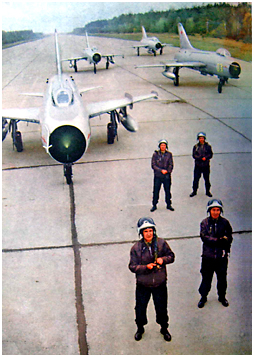 Photo d'une revue soviétique montrant des Su-7 du 20.GvIBAP sur la piste de réserve de Gross Dölln, en 1973. C'est à cette
époque que l'aérodrome s'est vu doter d'abris pour armes nucléaires de type Granit-2. © Collection HM.
Photo d'une revue soviétique montrant des Su-7 du 20.GvIBAP sur la piste de réserve de Gross Dölln, en 1973. C'est à cette
époque que l'aérodrome s'est vu doter d'abris pour armes nucléaires de type Granit-2. © Collection HM.
This picture from a Soviet magazine taken in 1973 shows Su-7s of the 20.GvIBAP on the reserve runway at Gross Dölln.
The Granit-2 nuclear weapons shelters of the base were built during the same period. © HM collection.
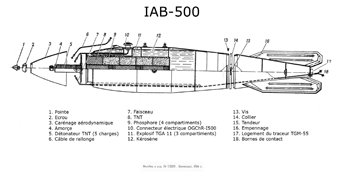 From the 1950s at the very latest, the CIA
conducted annual studies of the Soviet nuclear program.
In 1961, the document contained all the CIA's knowledge of the
nuclear infrastructure of Frontal Aviation, stating vaguely: "We believe the Soviets have operational storage sites
at a few airfields occupied by the Tactical Air Force [meaning Frontal Aviation] in Eastern Europe.
As no tactical missile nuclear warhead storage sites have been identified in Eastern Europe, it is possible that airfield sites
provide limited storage for ["Frog" and "Scud"] tactical missile units as well as for Soviet Tactical Air Force.
We do not know if the Soviets now store nuclear weapons at the sites in Eastern Europe." The focus of Western
intelligence-gathering was on possible storage facilities and the training activities of Frontal Aviation units.
These activities allowed for a more accurate conclusion than estimates about the nuclear infrastructure.
The annual USMLM report for 1969 was very informative about flight profiles, the activities of the 20.GvIBAP, stationed
at Parchim, being quite typical: "On 5 February Parchim "Fitter," "Moujik" [Su-7 two-seater] and "Fresco-C"
aircraft were observed active in multiple take-offs and landings. The 'Fitters' were also seen at altitude and,
at the centre of runway, executed a vertical climb in a simulated LABS maneuver." USMLM air teams documented
repeated simulated nuclear explosions on the Gadow-Rossow bombing range, south of Wittstock: "A possibly Rechlin
Lärz-subordinated "Fitter" was observed in practise LABS maneuvers over the Gadow-Rossow bombing and gunnery
range on 12 June. During one of the maneuvers, the "Fitter" released a bomb while in an approximately 90-degree
climb. Completing the climb with an Immelmann, it then departed the range on a northern heading. A similar bomb
release tactic was observed at this range in August of 1967."
From the 1950s at the very latest, the CIA
conducted annual studies of the Soviet nuclear program.
In 1961, the document contained all the CIA's knowledge of the
nuclear infrastructure of Frontal Aviation, stating vaguely: "We believe the Soviets have operational storage sites
at a few airfields occupied by the Tactical Air Force [meaning Frontal Aviation] in Eastern Europe.
As no tactical missile nuclear warhead storage sites have been identified in Eastern Europe, it is possible that airfield sites
provide limited storage for ["Frog" and "Scud"] tactical missile units as well as for Soviet Tactical Air Force.
We do not know if the Soviets now store nuclear weapons at the sites in Eastern Europe." The focus of Western
intelligence-gathering was on possible storage facilities and the training activities of Frontal Aviation units.
These activities allowed for a more accurate conclusion than estimates about the nuclear infrastructure.
The annual USMLM report for 1969 was very informative about flight profiles, the activities of the 20.GvIBAP, stationed
at Parchim, being quite typical: "On 5 February Parchim "Fitter," "Moujik" [Su-7 two-seater] and "Fresco-C"
aircraft were observed active in multiple take-offs and landings. The 'Fitters' were also seen at altitude and,
at the centre of runway, executed a vertical climb in a simulated LABS maneuver." USMLM air teams documented
repeated simulated nuclear explosions on the Gadow-Rossow bombing range, south of Wittstock: "A possibly Rechlin
Lärz-subordinated "Fitter" was observed in practise LABS maneuvers over the Gadow-Rossow bombing and gunnery
range on 12 June. During one of the maneuvers, the "Fitter" released a bomb while in an approximately 90-degree
climb. Completing the climb with an Immelmann, it then departed the range on a northern heading. A similar bomb
release tactic was observed at this range in August of 1967."
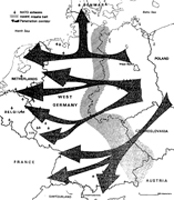
 "The two situations differed however in that the August
'67 release resulted in an air detonation of the weapon producing a large grey-black mushroom-shaped cloud, while the
release observed this date resulted in a normal ground burst.' Similar observations were also made with units
based in the south of the GDR, the 559.IBAP at Finsterwalde and the 497.IBAP at Grossenhain. That proved the nuclear
capability of all units equipped with Su-7 "Fitter-A": "On 7 October Finsterwalde-based "Fitter" performed a minimum
of four LABS delivery practice runs. The aircraft passed over the airfield at approximately 2,000ft, pulled up into
vertical climb to 3,500ft, pitched over, flew inverted for several seconds, then rolled over again departing to the
west. A very active program of local navigational, touch-and-go landings, LABS maneuvers, and possible range activity
was flown by Grossenhain-based "Fitter" and "Moujik" on 9 October."
"The two situations differed however in that the August
'67 release resulted in an air detonation of the weapon producing a large grey-black mushroom-shaped cloud, while the
release observed this date resulted in a normal ground burst.' Similar observations were also made with units
based in the south of the GDR, the 559.IBAP at Finsterwalde and the 497.IBAP at Grossenhain. That proved the nuclear
capability of all units equipped with Su-7 "Fitter-A": "On 7 October Finsterwalde-based "Fitter" performed a minimum
of four LABS delivery practice runs. The aircraft passed over the airfield at approximately 2,000ft, pulled up into
vertical climb to 3,500ft, pitched over, flew inverted for several seconds, then rolled over again departing to the
west. A very active program of local navigational, touch-and-go landings, LABS maneuvers, and possible range activity
was flown by Grossenhain-based "Fitter" and "Moujik" on 9 October."
| Low-Altitude Bombing System In order to be able to deliver a weapon with precision during a toss bombing or LABS manoeuvre, the original weapon system of the aircraft had to be supplemented by an additional switchbox and indicator. The latter was called PBK (Pritsel dliya Bombometaniya s Kabrirovaniya or toss-bombing sight). On early jets like the Su-7, the PBK was a separate box which was added to the left side of the instrument panel. A fixed point had to be selected on the ground to start the bombing run. That fixed point could be identified visually or it could be a radio beacon put in place by a commando unit or an helicopter. The PBK box gave to the pilot the informations necessary to complete its final bombing run (see > Hawk strike). HM. |
This chapter is an adaptation of the article entitled 'Nuclear Power' by Stefan Büttner, published in the March 2009 issue of Aircraft Illustrated (Ian Allan Publishing).
notes
(1) Like the tactical nuclear bombs, the IAB-500 was equipped with a remote or a direct impact fuse that determined the moment of detonation in order to create an aerial or a ground burst. Tactical nuclear bombs could be dropped using a LABS maneuver or during horizontal flight. In that latter case, a braking parachute was deployed behind the bomb.
 |
Special weapons > Part 2 > Part 3 |
 |
Plan du site - Sitemap |  |
